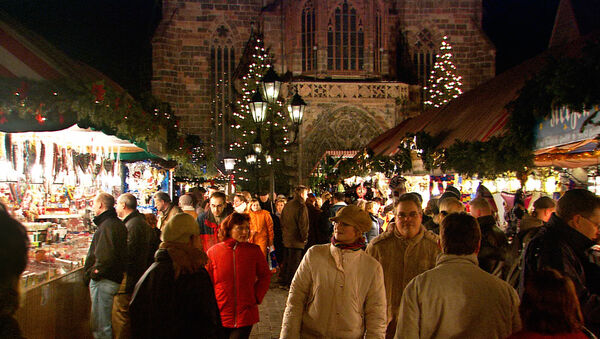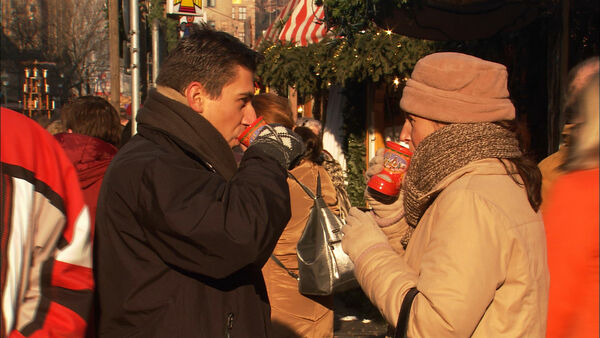Tips for Exploring Europe's Christmas Markets


All across Europe, Christmas markets serve up a healthy dose of holiday spirit. Hand-carved wooden ornaments and nativity scenes, lavish wreaths, and aromatic candles line the countless wooden stalls, strung with garlands and twinkle lights. I'm not much of a shopper; I prefer "cultural souvenirs" — experiences and memories — over stuff. But an atmospheric Christmas market offers ample opportunities for all of the above.
I once enjoyed browsing through one of Germany's most venerable Christmas markets, filling Nürnberg's main square with 200 wooden stalls. All around me, bundled-up shoppers and kids sampled fresh gingerbread, rode the carousel, and paused to listen to roving brass quintets. It was a magical holiday memory.
Traditionally, Christmas markets were especially popular in Germanic countries. In addition to Nürnberg's, some of the biggest and best-known are in Munich, Cologne, Heidelberg, Frankfurt, and Dresden's Striezelmarkt (which dates back to 1434). Zürich hosts Switzerland's biggest Christmas market, while Basel's and Bern's are cozier and more colorful. In Austria, the markets of Vienna, Salzburg, and Innsbruck are renowned. Germanic-flavored towns of France's Alsace (including Strasbourg and Colmar) and northern Italy (including Trento) also have fine markets.
But increasingly, other parts of Europe are getting in on the fun — from Zagreb to Copenhagen, from Edinburgh to Prague, from Gdańsk to Helsinki, and from Tallinn to Brussels. While all of these are big cities, smaller towns and villages also have Christmas markets. Many travelers find that they actually prefer the smaller markets, which can be more charming and far less crowded than the biggies.
Wherever you are, popular purchases include handicrafts (especially ornaments and other Christmas decor), woolens, gifty edibles (chocolates, jams, and liqueurs), and other local items. It's a smart strategy to do a "reconnaissance loop" to survey your options — for both souvenirs and food — before circling back to your favorite items. This also helps you identify mass-produced, generic goods that might have caught your eye at first...until you notice the same item at every stall. I'd rather seek out something unique and truly handmade; buying an item directly from the person who made it is a special experience. (Look for smaller vendors, specializing in just one thing, rather than ones crammed with dozens of different products.)
Christmas markets also come with an array of tempting food stands. Designed to warm up shivering shoppers, the dishes are typically rustic and hearty: fried potato dishes (including hash brown-like Rösti and potato pancake-like Kartoffelpuffer); fried dough (sweet or savory); raclette (gooey melted cheese over potatoes or on bread); pasta, Spätzle, or dumplings smothered in cheese; sautéed mushrooms; Flammkuchen (flatbread with toppings — i.e., Germanic pizza); and, of course, sausages. For snacks, you'll see roasted chestnuts and candied almonds — best when hot. Gingerbread (Lebkuchen) is another Christmas market staple, both edible (cookies, spiced cakes, small loaves) and decorative (ornaments in the shape of hearts, angels, and wreaths).
The quintessential Christmas market drink is hot mulled wine, spiced with cinnamon, cloves, and citrus fruits. It's called Glühwein in German, gløgg or glögg in Scandinavia, and the less-fun-to-say vin chaud in French. Feuerzangenbowle is similar, but topped with a rum-soaked sugar cube that's flambéed before your eyes and drips into the wine. Hot cocoa is also popular, along with some more interesting choices, such as Eierpunsch ("egg punch," the German answer to eggnog) or Jägertee (spiced and spiked tea).
Some drinks are served in a holiday-themed ceramic mug. You may be charged a deposit (Pfand), which will be refunded when you return the mug...or you can simply keep it as a souvenir. (When you finish your drink, exchange the mug for a clean one to take home.) Many markets feature different mug designs each year, making them a beloved collectible.
Some Christmas markets occupy a giant main square, while others feature a variety of independent, concurrent, smaller markets scattered throughout town. Admission to markets is typically free (except for certain indoor markets, in castles or other historic buildings). Within the market, you may have to pay for carnival rides, performances, special seating areas, and so on.
Do your homework: These days, most Christmas markets have official websites that list the dates, opening times, locations, vendors, schedules of musical performances and events, and other details. Many Christmas markets come not only with lots of holiday lights, but with more elaborate sound-and-light shows that it can be worth planning your visit around.
Layer up — be prepared for any weather. Comfortable (and, ideally, waterproof) shoes are a must. Bring an extra (collapsible) shopping bag or two, in case browsing turns to buying. While more and more vendors take credit cards, it's wise to have cash, including small change for mug deposits, pay-to-pee bathrooms, and so on. Keep an eye on valuables: Pickpockets enjoy Christmas markets just as much as shoppers do…probably more.
Most Christmas markets open up around mid- to late November. (With no Thanksgiving or "Black Friday" to kick off the holiday season, the start date can vary from place to place.) They carry on until around Christmas, with some continuing all the way into early January (no later than Epiphany, January 6). Most Christmas markets are closed on Christmas Day, and sometimes also on the 24th or 26th. And some German markets close for Totensonntag ("Sunday of the Dead"), the last Sunday before Advent. Smaller markets may be weekends-only. Also check the opening and closing times: Some markets don't open until afternoon, and many are officially closed by 7 or 8 p.m. In short, as you plan your itinerary, check to make sure you're clear on exactly when each market is open.
Christmas markets are busiest in the evenings, especially on weekends, when the twinkle-light ambience is cranked up to 11. For a quieter, less crowded experience, visit earlier, especially on weekdays. Late afternoon into early evening on a weekday can be the ideal "sweet spot": pleasantly bustling, but not overwhelming.
Whether you're an avid shopper, or simply looking for memorable holiday season ambience (and some Glühwein), Europe's Christmas markets enliven what can otherwise be a dreary time of year.

